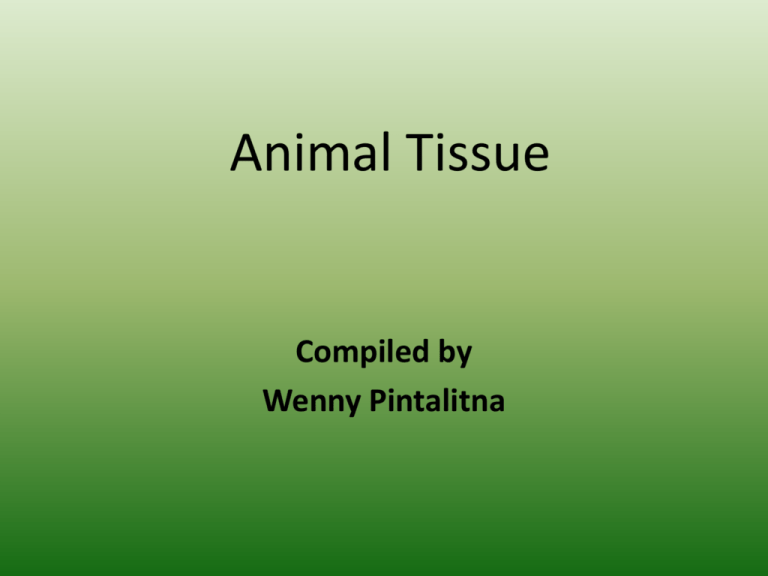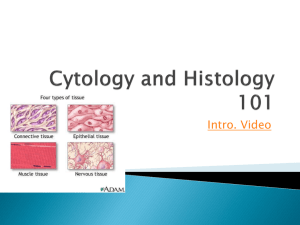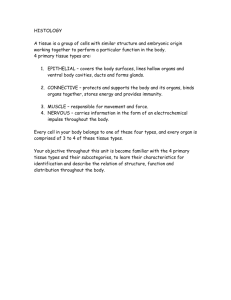Epithelial Tissue
advertisement

Animal Tissue Compiled by Wenny Pintalitna carbon atom DNA molecule organelle cell tissue biosphere ecosystem organ organ system community population organism FOUR MAIN TYPES OF ANIMAL TISSUES Epithelial Tissue (Covering) • Tightly-joined closely-packed cells (sel-sel yang padat,rapat, ketat) • One side of epithelium exposed to air, other side attached to a basement membrane, a dense mat of connective tissue (salah satu sisi jar.epitel berhubungan ke lingkungan external dan satu sisi lagi melekat pada membran basal,jar.ikat) • Covers outside of the body and lines internal organs and cavities (menutupi seluruh permukaan tubuh) • Provides surface for absorption, excretion and transport of molecules (membantu penyerapan, ekskresi dan transpor molekul) Types of Epithelial Tissue • Cell shape – Squamous – Cuboidal – Columnar • Number of cell layers – Simple – Pseudostratified – Stratified • RELATE STRUCTURE TO FUNCTION! Connective tissue (Framework) • Binding and support of other tissues (mengikat dan menyokong jaringan lain) • Large amount of extracellular matrix (banyak mengandung matiks extraselular) • Extracellular matrix consists of network of fibers in liquid, jelly-like or solid matrix Muscle Tissue (Movement) • Composed of long cells called muscle fibers • Contraction movement Nervous Tissue (Control) • Transmits nerve impulses from one part of an animal to another (menyampaikan impuls saraf dari satu bagian menuju bagian lain) • Consists of a cell body and long extensions called dendrites (towards cell body) and axons (towards another cell or an effector) (terdiri atas badan sel, dendrit, axon) Axon Dendrite Cell body Tissue Type Epithelial Connective Muscle Nerve Cell Shape Flattened, cuboidal, columnar Irregular or round Elongated Cell appendages branched Cell Arrangement Single multilayered Scattered in matrix In sheets or bundles Isolated or networked Location Body covering or lining organs or cavities Supports other organs Lining internal organs, make skeletal muscles Concentrated in brain and spinal cord + all over the body Surface Feature of Cells Cilia, microvilli - - - Matrix Type Basement membrane Varied – protein fibers + liquid, gelatinous, firm to calcified - - Matrix Amount Minimal Extensive Absent Absent Unique Feature No direct blood supply, except for glands Cartilage has no blood supply Can generate electrical signals, force and movement Can generate electrical signal Epithelial Tissue Compiled by Wenny Pintalitna Epithelia comes in 2 forms: 1. Glandular epithelia 2. Membranous epithelia Functions: • Protection • Absorption • Filtration • Excretion • Secretion • Sensory reception Types of Epithelium a. Shape of the cell • Cuboidal (like dice) • Columnar (like bricks on end) • Squamous (flat like floor tiles) b. Number of cell layer • Simple epithelium: a single layer of cells • Stratified epithelium: multiple tiers of cells • Pseudostratified • • • • • • Simple Squamous Epithelium Simple Cuboidal Epithelium Simple Columnar Epithelium Stratified Epithelium Pseudostratified Columnar Epithelium Transitional Epithelium “ciliated” literally = (see next page) eyelashes Stratified: regenerate from below Rare… Rare… Glandular epithelia Some epithelia, called glandular epithelia because absorb or secrete chemical solutions. • Glands • Line the lumen of the digestive and respiratory tracts form a mucous membrane Classification of glands • By where they release their product – Exocrine: external secretion onto body surfaces (skin) or into body cavities – Endocrine: secrete messenger molecules (hormones) which are carried by blood to target organs; “ductless” glands • By whether they are unicellular or multicellular Exocrine glands unicellular or multicellular Unicellular: goblet cell scattered within epithelial lining of intestines and respiratory tubes Product: mucin mucus is mucin & water Multicellular exocrine glands Epithelium-walled duct and a secretory unit Examples of exocrine gland products • • • • • • • Many types of mucus secreting glands Sweat glands of skin Oil glands of skin Salivary glands of mouth Liver (bile) Pancreas (digestive enzymes) Mammary glands (milk) Endocrine glands • Ductless glands • Release hormones into extracellular space – Hormones are messenger molecules • Hormones enter blood and travel to specific target organs • Transitional Transitional Simple Cuboidal Simple Squamous Simple Columnar • Colon • Intestine • Duodenum • • • • • • Loose Connective Tissue Dense Connective Tissue Adipose Tissue Cartilage Bone Blood TYPES OF CONNECTIVE TISSUE 1. True Connective Tissue a. Loose Connective Tissue b. Dense Connective Tissue 2. Supportive Connective Tissue a. Cartilage b. Bone 5. Liquid Connective Tissue a. Blood Classes of Connective Tissue: note the cell types and great variety of subclasses Connective tissue Functions mainly to bind and support other tissues. Three major components • Fiber collagenous fibers elastic fibers reticular fibers • Cell • Matrix Classes of Connective Tissue * Classes of Connective Tissue * Classes of Connective Tissue * Classes of Connective Tissue * Classes of Connective Tissue * Membranes that combine epithelial sheets plus underlying connective tissue proper • Cutaneous membranes – Skin: epidermis and dermis • Mucous membranes, or mucosa – Lines every hollow internal organ that opens to the outside of the body • Serous membranes, or serosa – Slippery membranes lining the pleural, pericardial and peritoneal cavities – The fluid formed on the surfaces is called a transudate • Synovial membranes – Line joints (a) Cutaneous membrane (b) Mucous membrane (c) Serous membrane • Skeletal Muscle Tissue • Smooth Muscle Tissue • Cardiac Muscle Tissue Biology 100 Human Biology Organ Systems Organ Systems Anatomical Terminology Relative Position 1. Superior = above; Inferior = below; 2. Anterior = front; Posterior = back; 3. Ventral = front; Dorsal = back; 4. Medial = center; Lateral = side; 5. Ipsilateral = same side; Contralateral = other side 6. Proximal = closer to trunk; Distal = farther from trunk; 7. Superficial = surface; Deep = internal. Anatomical Terminology Body Sections (cuts, planes) 1. Sagittal cut: divides the body into right and left portions. Midsagittal (median) = equal right and left portions. 2. Transverse Cut: (or horizontal): divides the body into superior and inferior portions 3. Coronal Cut: (or frontal): divides the body into anterior and posterior portions. 4. Cross-section: object cut at 90 degrees to long axis of the 5. Oblique section: cut at an angle across an object 6. Longitudinal section: cut with the long axis of an object Anatomical Terminology Anatomical Terminology






